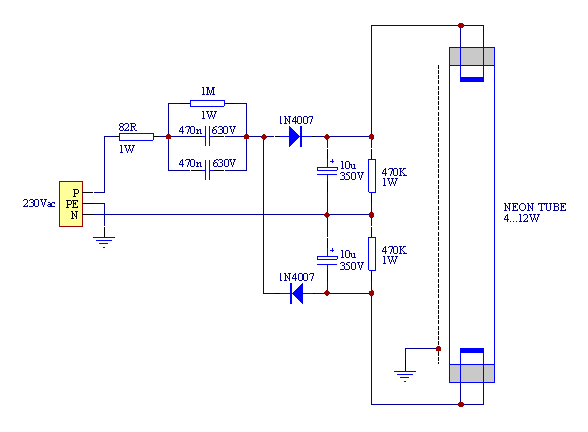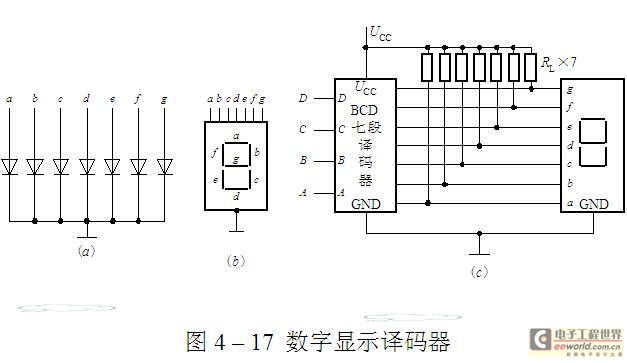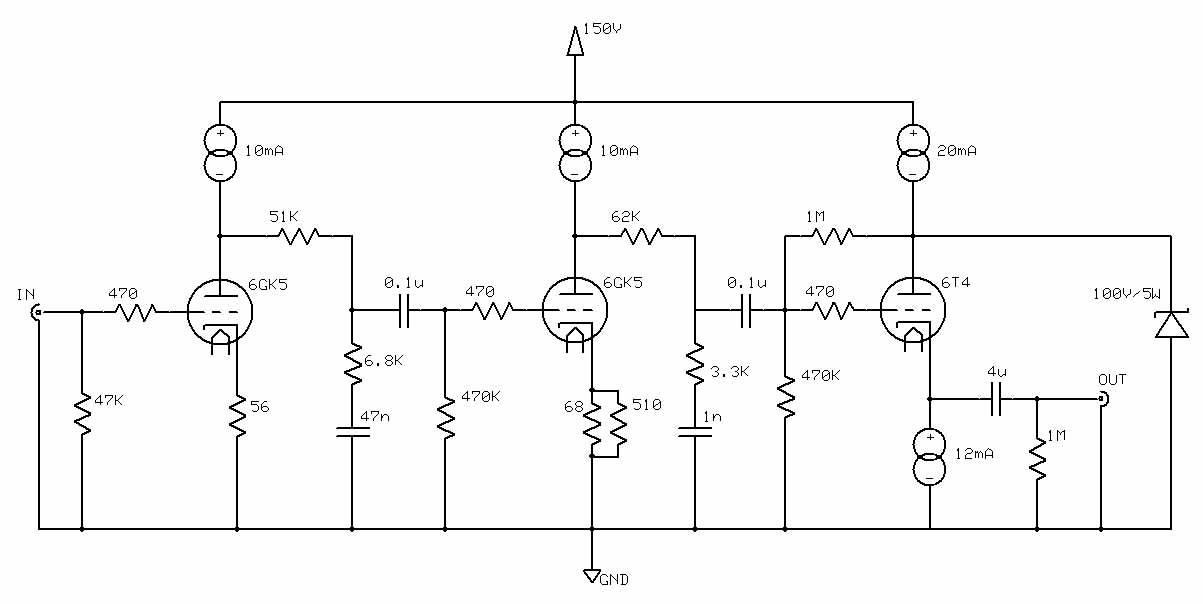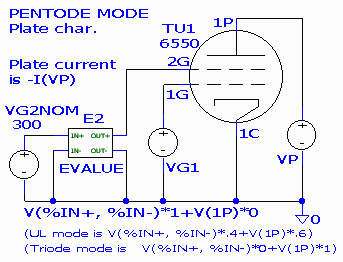
Driving a fluorescent tube

Even though a fluorescent tube is not a neon glow lamp and this page may not be the most appropriate location, this circuit is intriguing because it employs an unconventional method to power a common lamp. Similar to glow lamps, neon tubes consist of two electrodes within a low-pressure environment filled with a mixture of gases, typically argon and mercury, which produce ultraviolet light that is converted into white light by a fluorescent coating on the internal surface of the tube. When the tube is off, no current flows through it when the voltage between its electrodes is below a threshold voltage, which varies with the length of the tube, ranging from approximately 300V for shorter tubes to over 10kV for longer ones. To reduce this voltage by a factor of 10 and facilitate better starting of the tube, the electrodes are often heated by a current passing through them. Depending on the starting circuit, this current may be disabled after the tube has ignited. Once lit, the voltage between the electrodes decreases and remains relatively constant, even with variations in current (between 30V and 100V, depending on the tube length and gas composition). Fluorescent tubes are typically powered by alternating current (AC), but this circuit operates using direct current (DC). Essentially, this circuit functions as a voltage doubler, consisting of two 1N4007 diodes and two high-voltage electrolytic capacitors rated at 10µF - 350V, which generates a DC voltage exceeding 600V from a 230Vac mains supply when the tube is off. This circuit is not compatible with a 110Vac mains supply. For low-power tubes (e.g., 4W, 8W, or 12W), the 600V is sufficient to ignite the tube. Once the tube is illuminated, current flows through two 470nF - 630V capacitors, causing a voltage drop that maintains a service voltage of approximately 30V for the tube. A 1MΩ resistor and two 470kΩ resistors are included to discharge the capacitors when the circuit is powered off. If not discharged, the energy stored in the capacitors could be hazardous, even when the circuit is unplugged. As the lamp is directly connected to the mains, caution is advised to avoid contact with any part of the circuit. Since the electrodes are not heated, starting the tube may be challenging, especially if the lamp is old or excessively long. Touching the tube with one hand can sometimes assist in igniting it (for example, a 22W tube may light with this method). However, it is crucial to only touch the glass of the tube, as contacting any other part of the circuit poses significant danger. When the lamp is illuminated, it can be observed that the negative electrode (shown on the left in the accompanying image) appears darker than the positive one; this phenomenon is attributed to the Faraday dark zone, which is only visible when the tube is powered by DC current.
This circuit design leverages the principles of high-voltage generation and fluorescent tube operation, making it a valuable study in practical electronics. The use of a voltage doubler configuration effectively increases the input voltage to a level suitable for striking the fluorescent tube, while the incorporation of resistors ensures safe operation by allowing for the safe discharge of capacitors. The choice of components, such as the 1N4007 diodes, is critical for withstanding the high voltages involved, and careful attention to capacitor ratings is necessary to prevent component failure. The circuit's reliance on direct current presents unique challenges, particularly in the starting phase of the tube, where the absence of heated electrodes requires alternative methods to initiate the discharge process. The observation of the Faraday dark zone under DC operation provides an interesting visual cue regarding the behavior of the tube, further emphasizing the differences between AC and DC powered fluorescent lamps. Overall, this circuit exemplifies innovative engineering solutions for utilizing fluorescent technology in non-traditional power configurations.Even if a fluorescent tube it`s not a neon glow lamp and this page it`s not maybe at the right place, this circuit is very interesting because it uses an odd way to power a very common lamp. Like glow lamps, neon tubes are composed by two electrodes in a low pressure atmosphere composed by a mixture of gazes; usually argon and mercury producing UV
light that is converted into white light by a fluorescent layer on the internal surface of the tube. When the tube is off no current can flow through it when the voltage between its electrodes is lower than a threshold voltage (it varies with the length of the tube from about 300V for the smallest ones, up to more than 10kV for the longest ones).
To reduce this voltage by a factor of 10 and make the tube start better the electrodes are often heated by a current flowing through them. Depending on the start circuit this current may (or may not) be shut off after the tube has started. Once the tube is lit, the voltage between its electrodes falls and remain roughly constant even if the current is varied (between 30 and 100V depending on the length of the tube and on the gas inside).
Fluorescent tubes are often powered with AC current, but with this circuit we will drive it in DC. Basically this circuit is a voltage doubler (composed by the two diodes 1N4007 and the two high voltage electrolytic capacitors of 10uF - 350V) that generates, when the tube is off, a DC voltage of more than 600V from a 230Vac main. Unfortunately this circuit doesn`t work with a 110Vac main. If a low power tube is used (for example 4, 8 or 12W) these 600V are enough to strike the it. Once the tube lit, a current starts flowing through the two capacitors of 470nF - 630V that causes a voltage drop that ensures the service voltage of about 30V for the tube.
The 1M © resistor and the two 470k © resistors are useful for discharging the capacitors when the circuit is switched off. If not discharged, the energy stored in the capacitors could be lethal even when the circuit is unplugged.
Since the lamp is directly connected to the main, one should avoid touching any part of it and be very careful anyway. Since in this case the electrodes are not heated, starting the tube can be a little difficult when the lamp is old or too long.
Touching the tube with one hand usually helps (with a little help of my hand I could light a 22W tube). But be extra careful and just touch the glass of the tube; it`s very dangerous to touch any other part of the circuit.
When the lamp is lit, one can remark that the negative electrode (in the picture on the left) is darker than the positive one: this is due to the Faraday dark zone, that is only visible when the tube is powered with DC current. 🔗 External reference
This circuit design leverages the principles of high-voltage generation and fluorescent tube operation, making it a valuable study in practical electronics. The use of a voltage doubler configuration effectively increases the input voltage to a level suitable for striking the fluorescent tube, while the incorporation of resistors ensures safe operation by allowing for the safe discharge of capacitors. The choice of components, such as the 1N4007 diodes, is critical for withstanding the high voltages involved, and careful attention to capacitor ratings is necessary to prevent component failure. The circuit's reliance on direct current presents unique challenges, particularly in the starting phase of the tube, where the absence of heated electrodes requires alternative methods to initiate the discharge process. The observation of the Faraday dark zone under DC operation provides an interesting visual cue regarding the behavior of the tube, further emphasizing the differences between AC and DC powered fluorescent lamps. Overall, this circuit exemplifies innovative engineering solutions for utilizing fluorescent technology in non-traditional power configurations.Even if a fluorescent tube it`s not a neon glow lamp and this page it`s not maybe at the right place, this circuit is very interesting because it uses an odd way to power a very common lamp. Like glow lamps, neon tubes are composed by two electrodes in a low pressure atmosphere composed by a mixture of gazes; usually argon and mercury producing UV
light that is converted into white light by a fluorescent layer on the internal surface of the tube. When the tube is off no current can flow through it when the voltage between its electrodes is lower than a threshold voltage (it varies with the length of the tube from about 300V for the smallest ones, up to more than 10kV for the longest ones).
To reduce this voltage by a factor of 10 and make the tube start better the electrodes are often heated by a current flowing through them. Depending on the start circuit this current may (or may not) be shut off after the tube has started. Once the tube is lit, the voltage between its electrodes falls and remain roughly constant even if the current is varied (between 30 and 100V depending on the length of the tube and on the gas inside).
Fluorescent tubes are often powered with AC current, but with this circuit we will drive it in DC. Basically this circuit is a voltage doubler (composed by the two diodes 1N4007 and the two high voltage electrolytic capacitors of 10uF - 350V) that generates, when the tube is off, a DC voltage of more than 600V from a 230Vac main. Unfortunately this circuit doesn`t work with a 110Vac main. If a low power tube is used (for example 4, 8 or 12W) these 600V are enough to strike the it. Once the tube lit, a current starts flowing through the two capacitors of 470nF - 630V that causes a voltage drop that ensures the service voltage of about 30V for the tube.
The 1M © resistor and the two 470k © resistors are useful for discharging the capacitors when the circuit is switched off. If not discharged, the energy stored in the capacitors could be lethal even when the circuit is unplugged.
Since the lamp is directly connected to the main, one should avoid touching any part of it and be very careful anyway. Since in this case the electrodes are not heated, starting the tube can be a little difficult when the lamp is old or too long.
Touching the tube with one hand usually helps (with a little help of my hand I could light a 22W tube). But be extra careful and just touch the glass of the tube; it`s very dangerous to touch any other part of the circuit.
When the lamp is lit, one can remark that the negative electrode (in the picture on the left) is darker than the positive one: this is due to the Faraday dark zone, that is only visible when the tube is powered with DC current. 🔗 External reference





